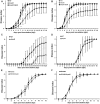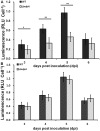Involvement of NpdA, a Putative 2-Nitropropane Dioxygenase, in the T3SS Expression and Full Virulence in Ralstonia solanacearum OE1-1
- PMID: 29075251
- PMCID: PMC5641582
- DOI: 10.3389/fmicb.2017.01990
Involvement of NpdA, a Putative 2-Nitropropane Dioxygenase, in the T3SS Expression and Full Virulence in Ralstonia solanacearum OE1-1
Abstract
Previously, we isolated several genes that potentially affected the expression of type III secretion system (T3SS) in Ralstonia solanacearum OE1-1. Here, we focused on the rsp0316, which encodes a putative 2-nitropropane dioxygenase (hereafter designated NpdA). The deletion of npdA substantially reduced the T3SS expression and virulence in OE1-1, and the complementation with functional NpdA could completely restore its reduced T3SS expression and virulence to that of wild type. The NpdA was highly conserved among diverse R. solanacearum species and the NpdA-dependent expression of T3SS was not specific to OE1-1 strain, but not the virulence. The NpdA was important for the T3SS expression in planta, while it was not required for the bacterial growth in planta. Moreover, the NpdA was not required for the elicitation of hypersensitive response (HR) of R. solanacearum strains in tobacco leaves. The T3SS in R. solanacearum is directly controlled by the AraC-type transcriptional regulator HrpB and regulated by a complex regulation network. The NpdA affected the T3SS expression mediated with HrpB but through some novel pathway. All these results from genetic studies demonstrate that NpdA is a novel factor for the T3SS expression in diverse R. solanacearum species in medium, but specifically for the T3SS expression in strain OE1-1 in planta. And the NpdA-dependent expression of T3SS in planta plays an important role in pathogenicity of R. solanacearum OE1-1 in host plants.
Keywords: Hrp regulon; NPD; Pathogenesis; Ralstonia solanacearum; type III secretion system.
Figures







Similar articles
-
A putative LysR-type transcriptional regulator PrhO positively regulates the type III secretion system and contributes to the virulence of Ralstonia solanacearum.Mol Plant Pathol. 2018 Jan 24;19(8):1808-19. doi: 10.1111/mpp.12660. Online ahead of print. Mol Plant Pathol. 2018. PMID: 29363870 Free PMC article.
-
PrhN, a putative marR family transcriptional regulator, is involved in positive regulation of type III secretion system and full virulence of Ralstonia solanacearum.Front Microbiol. 2015 Apr 28;6:357. doi: 10.3389/fmicb.2015.00357. eCollection 2015. Front Microbiol. 2015. PMID: 25972849 Free PMC article.
-
Functional Characterization of RsRsgA for Ribosome Biosynthesis and Expression of the Type III Secretion System in Ralstonia solanacearum.Mol Plant Microbe Interact. 2020 Jul;33(7):972-981. doi: 10.1094/MPMI-10-19-0294-R. Epub 2020 Jun 1. Mol Plant Microbe Interact. 2020. PMID: 32240066
-
Regulation Involved in Colonization of Intercellular Spaces of Host Plants in Ralstonia solanacearum.Front Plant Sci. 2017 Jun 8;8:967. doi: 10.3389/fpls.2017.00967. eCollection 2017. Front Plant Sci. 2017. PMID: 28642776 Free PMC article. Review.
-
[Advances in studies of the type III secretion system in Ralstonia solanacearum--A review].Wei Sheng Wu Xue Bao. 2015 Jun 4;55(6):675-82. Wei Sheng Wu Xue Bao. 2015. PMID: 26562991 Review. Chinese.
Cited by
-
Functional characterization of two 3-dehydroquinases of AroQ1 and AroQ2 in the shikimate pathway and expression of genes for the type III secretion system in Ralstonia solanacearum.Front Microbiol. 2023 Apr 26;14:1186688. doi: 10.3389/fmicb.2023.1186688. eCollection 2023. Front Microbiol. 2023. PMID: 37180250 Free PMC article.
-
Peculiarities of nitronate monooxygenases and perspectives for in vivo and in vitro applications.Appl Microbiol Biotechnol. 2021 Nov;105(21-22):8019-8032. doi: 10.1007/s00253-021-11623-1. Epub 2021 Oct 16. Appl Microbiol Biotechnol. 2021. PMID: 34655320 Review.
References
-
- Angot A., Peeters N., Lechner E., Vailleau F., Baud C., Gentzbittel L., et al. (2006). Ralstonia solanacearum requires F-box-like domain-containing type III effectors to promote disease on several host plants. Proc. Natl. Acad. Sci. U.S.A. 103 14620–14625. 10.1073/pnas.0509393103 - DOI - PMC - PubMed
LinkOut - more resources
Full Text Sources
Other Literature Sources

